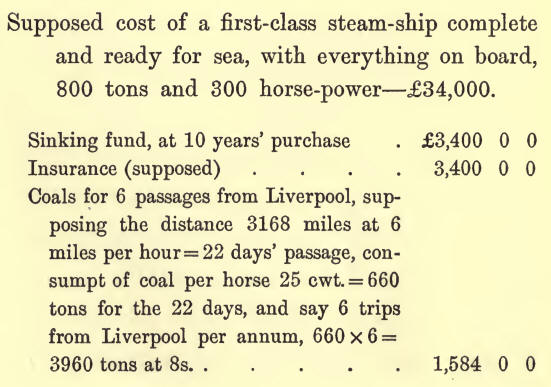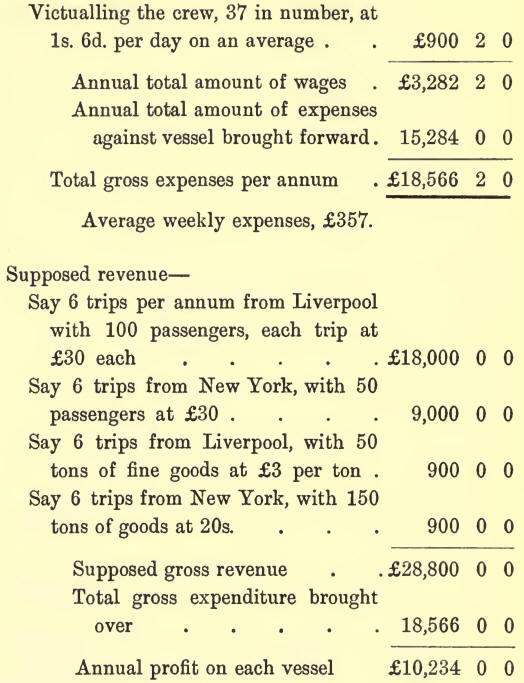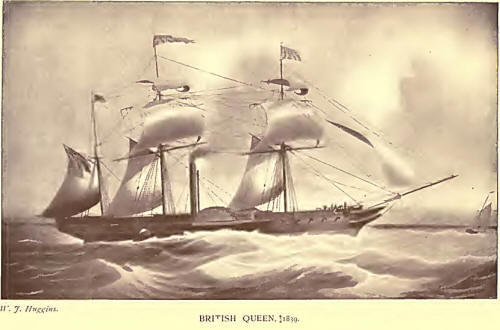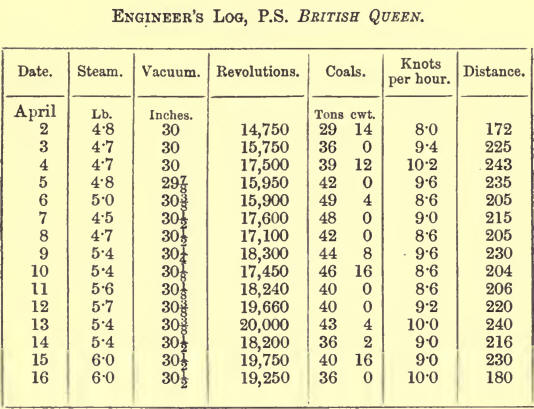|
It is now incumbent on us to show the part that
Robert Napier took in the inception of Atlantic steam navigation.
Hitherto what he had undertaken to do had been successfully
accomplished, and his work had been characterised by great
thoroughness; but at the same time it must be remembered that nearly
all the vessels had been built for short - distance runs in
comparatively quiet waters.
When he undertook the contract for the Dundee boats
he said he had a purpose in view, and there can be little doubt that
this object was to build an Atlantic steamer.
Between Britain and America there' was at this time a
regular and increasing trade conducted by sailing-packets.
In 1819 the Savannah, a small sailing-ship of 350
tons, with auxiliary paddles, came across from America to this
country partly under steam, but chiefly under sail. Her performance,
however, was considered so unsatisfactory that her engines were
taken out in the following year, and up to the end of 1832 no
further attempt was made to cross by steam.
In August 1833 the Royal William steamed over from
Quebec, but prior to this date the subject of trans-Atlantic
navigation had been fully dealt with by Napier.
In the beginning of 1833 he was consulted by Mr
Patrick Wallace of London regarding a regular service of
steam-vessels betwixt Liverpool and New York, and his reply, dated
3rd April of that year, is subjoined. The letter is a long one, but
we reproduce it in its entirety as showing how carefully Napier had
studied the problem in all its bearings, and what a clear conception
he had of the whole situation, of the requirements of the trade, and
the size, speed, and strength of the vessels necessary for success.
This forecast is all the more remarkable, as he had nothing to guide
him, and the opinions of professed experts such as Dr Dionysius
Lardner were not encouraging.
“Vulcan Foundry, Glasgow, 3rd April 1833.
“Dear Sir,—I am sorry that it has been out of my
power to write you sooner. I now send you my opinion, with some
remarks about the proposed speculation for establishing
steam-vessels betwixt Liverpool and New York, with an estimate of
the probable cost of fitting out and sailing these vessels. Before
going into details,
I may mention that I have endeavoured to state
everything as fairly and candidly as possible, so as not to mislead
you or your friends, and have rather overestimated the cost and
expense than otherwise. The amount of revenue, I am aware, can only
be an approximation to the truth, for in all new undertakings of any
magnitude many things occur that cannot be foreseen; but judging
from what has taken place in other stations where steam-vessels have
been introduced, it is reasonable to calculate upon a very great
increase of revenue in a short time. But in an undertaking of such
magnitude as the one proposed, it is of the greatest importance that
the whole be reviewed in a broad and liberal manner at the outset,
and everything that can be brought to bear either for or against the
interest of the speculation, fairly weighed and balanced before
anything is decided upon. If your friends are in earnest about
entering upon the speculation, they should make up their minds to
meet with strong opposition and other difficulties for a short time.
But if they enter upon it with a determination to meet opposition
and difficulties spiritedly, and to overcome them, then I have not
the smallest doubt upon my own mind but that in a very short time it
will be one of the best and most lucrative businesses in the
country, provided always that the Company set out right at first by
having first-class vessels fully suited for the trade in every
department. I am aware that in getting up the first of these vessels
great care and attention will be necessary to gain the different
objects in view, and in doing this an extra expense may be incurred,
but which may be avoided in all the other vessels. If the practical
difficulties, &c., are fairly surmounted in the first vessels,—and
which I have no doubt but they may,—the first cost and sailing
expenses of the two first vessels ought not so much to be taken into
account. In fact, I consider it as nothing compared with having them
so efficient as to set all opposition at defiance, and to give
entire confidence to the public in all their arrangements and
appointments, cost what it may at first; for upon this depends
entirely the success, nay, the very existence, of the Company.
“I wish it therefore to be impressed upon the minds
of your friends the great necessity of using every precaution that
can be thought of to guard against accidents on such a long passage,
and if accidents should happen, to be prepared with a remedy to meet
any common one that may occur, as far as possible. By attending to
this you will give confidence to the public and comfort to
yourselves, and in the end I am certain it will more than repay you.
“The plan I would propose with regard to the whole of
the engineer department is: I would endeavour to get a very
respectable man, and one thoroughly conversant with his business as
an engineer; I would appoint this man to be master engineer, his
duty to superintend and direct all the men and operations about the
engines and boilers, &c., to be accountable to the captain for his
conduct—viz., to be under the captain. All the other men for working
the engines should be regular bred tradesmen, and all the firemen
boiler-makers. A workshop, with a complete set of tools and
duplicates of all the parts of the engines that are most likely to
go wrong, should be on board. In a word, I would have everything
connected with the machinery very strong and of the best materials,
it being of the utmost importance to give confidence at first, for
should the slightest accident happen so as to prevent the vessel
making her passage by steam, it would be magnified by the
opposition, and thus, for a time at least, mar the progress of the
Company. But if, on the other hand, the steam-vessels are successful
in making a few quick trips at first, and beating the sailing
vessels very decidedly, then you may consider the battle won and the
field your own.
“With regard to the size of the vessels, I am
decidedly of opinion they should not be less than 800 tons,—probably
more,— and propelled by two engines of not less than 150 horse-power
each, or 300 in whole, so as to ensure good passages in almost any
kind of weather. The model of the vessels should be such as is best
adapted for great speed, and carrying a large cargo on a moderate
draught of water ; but upon no account should the model be
sacrificed for the sake of cargo, for the future success of the
Company depends in having fastsailing steamers as well as good ones.
“In the estimate I have made of the probable cost of
such vessels as will suit your purpose, I have thought it prudent to
make a considerable allowance for extras to the two first
vessels—viz., I have considered the vessels completely ready for
sea, with everything on board necessary for the vessel and
machinery—viz., sails, rigging, anchors, cables, cabin furniture
complete, engines and machinery duplicates, tools, iron tanks for
coals, and water to trim the vessel. In a word, everything complete
for the passage.
“From an official document I have, I find that the
number of passengers that have left the Clyde for two years is as
under:
For New York—
In the year 1831, 1336 passengers; and In the year
1832, 1672 passengers.
For the British Colonies in N. America—
In the year 1831, 3062 passengers;
In the year 1832, 3273 passengers.
To the above may be added all that leave this country
for debt, &c. From the North of Ireland—viz., Belfast and
Londonderry —a very great number of passengers go annually to the
States and Colonies. A great proportion of them could not afford to
go by steam; still there would be a number that would go.
“I have mislaid the document I had for the average
number of passengers that regularly sail from Liverpool every week.
I am, however, in daily expectation of a correct list of the number
of the ships, which, if I think of any use to you, I will send it.
You no doubt are aware that the best time for passengers is the
spring and fall of the year. One of the Packet's ships last fall had
£1800 of passage-money from New York. The two last ships that sailed
from Liverpool had about £1000 each of passage - money. Cabin fare,
35 guineas to New York and 30 to Liverpool; fine goods, Is. per
foot. A Packet ship leaves Liverpool every week. Besides the regular
Packet ships, about 170 vessels averaging 400 tons each have left
Liverpool for New York from the 1st March 1832 to the 1st March
1833, and in the same time about 90 vessels about the same burden
have left Liverpool for New Orleans, making a total of 260 ships
from Liverpool, which all carry more or less passengers, a number of
whom I have no doubt would go by steam were it once fairly
established.



“From all I can
judge, I am convinced the number of passengers that are likely to go
regularly are rather under than over stated, but I expect to be able
in a few days to form a more correct estimate of the whole.
“I hope you will excuse me putting you to so much
postage, but really I have not time to write you a short letter.
“I shall be glad to hear from you, and am, dear Sir,
yours very truly,
“Robert Napier.
“To Patrick Wallace, Esq.,
London.”
No business resulted with Mr Wallace and his friends,
and the project fell through from lack of funds.
A proposal was made to Mr Napier that he should put
his ideas into practice and build a large steamer on speculation;
but while he gave the matter consideration he came to the conclusion
that the risk attending such a venture would be too great. His view
was that the hull should be about 220 feet long, with 40 feet beam;
and he estimated the cost of such a vessel with large engines to be
about £50 per ton. It may be noted that these dimensions were
approached in the Great Western (the first vessel to cross without
re-coaling), and exceeded in the case of the British Queen, which
measured 245 feet long by 40 feet beam.
An opportunity soon thereafter afforded itself of
showing what he could do on the Atlantic. In 1836 the British and
American Steam Navigation Company was formed, with a capital of
£1,000,000 sterling. Mr Macgregor Laird, with whom Napier was
intimate, took a prominent part in the formation of this Company,
and was appointed secretary. The Company resolved to order a large
steamer, and Mr Laird entered into negotiations with Napier, who
offered to supply the engines, which were of unusual size, at £50
per nominal horse-power, and to look after the building of the hull
for a fee of £1000 sterling. Hall’s condensers were thought to be
desirable ; but at first Napier was not willing to supply them, as
his limited experience with such condensers had cast a doubt in his
mind on their reliability, and he was against introducing a novelty
in a large pair of engines.
In October he made a definite offer to supply the
machinery with Hall's condensers for £20,000 sterling, but his
tender was not accepted, and the order was placed with Messrs Claude
Girdwood & Co. This firm, however, was not able to implement the
contract, and about a year later Napier was asked to undertake the
work, which he did at a price considerably above his original offer.
The engines were much larger than any he had hitherto
made, the cylinders being 77½ inches and the stroke 7 feet. The hull
of the vessel was built by Messrs Curling & Young of London, but
Napier took care to give the builders special directions as to the
strength and fastening of the engine keelsons, paddle-beams, &c., so
that his machinery should be rigid; and it was said that whatever
else might break up, the part connected with the engines would stick
together,—a fact which was brought home to the ultimate purchasers
of the vessel when they dismantled her.

The British Queen, which cost £60,000 sterling, was a
magnificent steamer, and much larger than the early Cunard boats.
There was a very bitter feeling raised that such a fine vessel built
on the Thames should be engined in Scotland, and an acrimonious
correspondence on the subject was carried on for a long time in the
‘Mechanics’ Magazine under the heading
of “London versus Country-made Engines,”—an attempt being made to
decry the Scottish contractor. Napier’s motto was “Deeds, not
Words,” and after the vessel had been running for a year he emerged
triumphant, one of the correspondents writing, “I will only ask
where the engines of the British Queen can be matched, in any
respect whatever, either for strength of material in proportion to
their power, for beauty of design, for smoothness while in motion,
and above all, for the high state of perfection in which the engines
perform their duty?” which challenge was unanswered. Comparison was
instituted between the engines of the British Queen and those of
the Great Western, made by Maudslay, when it transpired that the
framing of the latter had given way and required to be patched with
malleable iron straps.
The speed of the vessel was taken from an average of
the Dundee and Perth boats, and was intended to be a mean of 9 knots
an hour in all weathers, so that she might make the passage from
London to New York in 14 to 15 days. This estimated speed was
accomplished on service with a daily consumption of forty tons of
coal.
She was launched in May 1838, and sent round at once
to the Clyde receive her machinery; but from various causes she did
not make her first voyage till 12th July 1839, sailing on that date
from Spithead with a full complement of goods and passengers. She
made the passage in 151-days, her best day’s steaming being 240
knots.
The details of the performance of what was then
considered an Atlantic greyhound, with boilers working at 5 lb.
pressure, are interesting, and we submit an extract from the
engineer’s log, giving particulars of the vessel’s fourth voyage
from New York to London :—

Total number of revolutions from New York to
Portsmouth, 263,400 ; total quantity of coals, 613 tons 16 cwt. Left
New York 1st April 2.30 p.m. ; arrived at Spithead 16th April 1840
at 6p.m.
The British and American Company originally
contemplated building two vessels in America and two in this
country, and they intended to run steamers twice a-month to New
York, starting alternately from London and Liverpool. With this
view they ordered the President and another steamer,
and proposed following with similar large vessels; but the advent of
the subsidised Cunard Line and the loss of the President, which
sailed from New York in 1841 and was never again heard of, caused
the enterprise to end in failure. |

